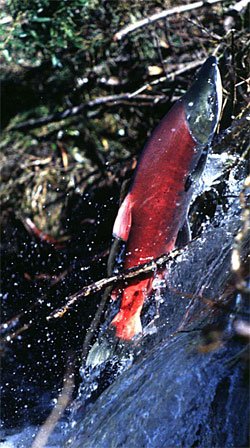
A lot of research has been done trying to figure out how the salmon know the way back to the specific stream from which they hatched. Well, each stream has it own mix of soil, rocks, and other environmental elements. As a result, each stream has its own specific mix of chemicals. Most of the data indicate that a salmon remembers the specific chemical makeup of its original stream. Once it gets back to freshwater, then, it starts following a “chemical trail” that will lead it back to the stream from which it hatched.1
While this is rather impressive, it doesn’t really tell us about the most difficult navigational aspect of the journey. The salmon spends a long time in the ocean growing and maturing. As a result, it often ranges far from the place where it entered the ocean. How does it find its way back to the correct freshwater inlet that will lead to the correct stream? It seems hard to believe that it could follow a “chemical trail” that far! Since we know that salmon are equipped with biological machinery that allows them to sense the earth’s magnetic field, it has been thought for some time that salmon use magnetic guidance to get them to the proper freshwater inlet.2
While that’s a reasonable conclusion based on what we know, there hasn’t been a lot of evidence to back it up. However, a recent study published in Current Biology has begun to remedy that situation.
In this study, the researchers analyzed 56 years worth of fisheries’ data on Fraser River sockeye salmon. These salmon spend two years in the ocean before returning to Fraser River in British Columbia, Canada. They then navigate the river to find the specific stream in which they were born. Interestingly enough, however, the fish have to make a choice before they reach the river, because Vancouver Island stands between the river and the open ocean. So the fish must either navigate around the northern side of the island or the southern side of the island to reach the river.
Because the details of the earth’s magnetic field change a bit from year-to-year, the specific magnetic field the salmon encounter when they return to the Fraser River is slightly different from when they left. Sometimes, the northern side of the island best resembles the magnetic field they encountered when they first entered the ocean, and sometimes the southern side of the island is the closest magnetic match. The researchers showed that when the northern side of the island was the closest magnetic match to what they encountered when they first entered the ocean, most of the salmon traveled the northern route. However, when the southern side of the island was the closest magnetic match, most of the salmon traveled the southern route.3
This leads the authors to conclude that as the salmon leave the river and hit the ocean, they “imprint” the details of the earth’s magnetic field at that point. That way, when it is time to reproduce, they can use the earth’s magnetic field to guide them back to the river they originally used to enter the ocean. Once they reach the river, they eventually switch to chemical guidance, which leads them to the specific stream from which they hatched.
Now it is important to note that this study is by no means definitive. There were other factors that affected which route the salmon took around Vancouver Island. Temperature, for example, was more important than the magnetic field. The warmer the ocean was that year, the more salmon took the northern route. In fact, the researchers concluded that temperature accounted for 22% of the variation in the route taken, while magnetic field accounted for only 16%. The interaction between temperature and magnetic field accounted for 28% of the variation. Thus, while this study provides evidence that the magnetic field plays a role in the navigation of salmon, it doesn’t tell us exactly how important that role is.
Given that caveat, I still think it’s really amazing that based on what we know now, salmon seem to have at least two different navigation systems: a magnetic one that leads them to the correct freshwater inlet, and a chemical one that leads them to their final destination. God’s creation is truly marvelous!
REFERENCES
1. Hugh Dingle, Migration: The Biology of Life on the Move, Oxford University Press 1996, p. 204
Return to Text
2. Bror Jonsson, Ecology of Atlantic Salmon and Brown Trout: Habitat As a Template for Life Histories (part of the Fish and Fisheries series), Springer 2011, pp. 293-294
Return to Text
3. Nathan F. Putman, Kenneth J. Lohmann, Emily M. Putman, Thomas P. Quinn, A. Peter Klimley, and David L.G. Noakes, “Evidence for Geomagnetic Imprinting as a Homing Mechanism in Pacific Salmon,” Current Biology, doi:10.1016/j.cub.2012.12.041, 2013
Return to Text

Have the biological structures that help to measure the magnetic field and chemical composition around the salmon been identified or is that still a mystery?
Both the chemical and magnetic sensing structures have been found. The magnetic sensing structures are composed of magnetite particles (Fe3O4) whose position is sensed by nerves. These structures are distributed throughout the lateral line of the salmon. The chemical sensing structures are a part of the olfactory system.